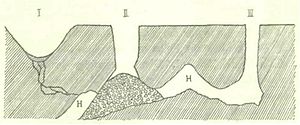Throat (geology)
As throat or sinkhole in geology and geography, a surface shape is known that particularly common in karst regions occurs with low terrain slope: a deep-reaching, usually circular hole of several meters in diameter. In the carbonate rock, gullies can appear at intervals of a few hectometers and can be seen as small sinkholes with extremely steep walls. They arise from fissures and joints in the rock, through which carbonated water penetrates and initiates the dissolution of the lime (or dolomite). As a result, the fissures are transformed into tubes and steepened by the flow of water. At greater depths, cavities with an underground network of water and often cave systems form .
The shaft-like or funnel-like holes represent a danger for hikes in the limestone Alps and similar mountains, especially if they are overgrown by mountain pines (leg pines) or covered by snow. In good hiking maps , all gullies near the road are therefore marked as black points and are often referred to as "Schl".
Karst geologists also speak of the gullet when a wide sinkhole narrows in the depths. This narrow drain for rainwater or meltwater then leads down to the cave river or dammed karst water.
Sometimes a gullet becomes a sinkhole when the tube absorbs more and more surface water: the funnel shape of the sinkhole is finally formed by the chemical and mechanical activity of the water running into the gullet .
See also
Sources and web links
- Hans Murawski: Geological Dictionary . Enke-Verlag, Stuttgart 1977
- Alpine dangers: sinkholes, gullies and crevices
